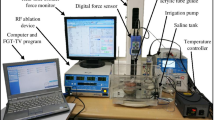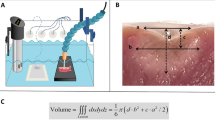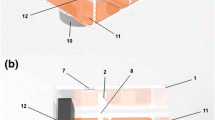Abstract
Purpose
Contact force (CF) catheters are useful to address proper contact during ablation. However, interactions between the ablation process, or its associated irrigation flow changes, with the CF sensing may translate into unexpected CF value fluctuations. We aimed to test for unintentional CF value variations during radiofrequency applications at a fixed applied force, with two commercially available catheters (TactiCath™ and SmartTouch™), and to evaluate its theoretical clinical significance by correlating CF-derived automatic ablation algorithms (force-time integral and lesion index) and actual lesion size at two standard CF values.
Methods
Four series of 20 perpendicular epicardial ablations (20 W, 60 s, 17 ml/min) were performed on porcine left ventricle submerged in 37 °C saline. Catheters were mechanically fixed at a constant position and evaluated at 10 and 20 g. CF values were digitally analysed before each application changing irrigation rate (2–17–30 ml/min), and during ablation. Finally, lesions were quantified.
Results
Increasing irrigation before ablation led to a slight but significant CF decrease. During ablation, CF showed a reproducible pattern: fast initial decrease, subsequent increase until higher-than-initial values and final plateau phase (CF variation up to 69% at 10 g). CF variability was significantly higher at 10 g and using TactiCath™. There were no major differences in lesion size between catheters at the same initial CF. CF only correlated mildly to lesion measures, and automatic algorithms globally failed to predict lesion size.
Conclusions
CF measured values spontaneously vary during ablation following a predictable pattern (initial decrease, subsequent increase and final plateau). This is especially remarkable applying lower CF.







Similar content being viewed by others
References
Yokoyama K, Nakagawa H, Shah DC, Lambert H, Leo G, Aeby N, et al. Novel contact force sensor incorporated in irrigated radiofrequency ablation catheter predicts lesion size and incidence of steam pop and thrombus. Circ Arrhythm Electrophysiol. 2008;1:354–62.
Perna F, Heist EK, Danik SB, Barrett CD, Ruskin JN, Mansour M. Assessment of catheter tip contact force resulting in cardiac perforation in swine atria using force sensing technology. Circ Arrhythm Electrophysiol. 2011;4:218–24.
Reddy VY, Shah D, Kautzner J, Schmidt B, Saoudi N, Herrera C, et al. The relationship between contact force and clinical outcome during radiofrequency catheter ablation of atrial fibrillation in the TOCCATA study. Heart Rhythm. 2012;9:1789–95.
Neuzil P, Reddy VY, Kautzner J, Petru J, Wichterle D, Shah D, et al. Electrical reconnection after pulmonary vein isolation is contingent on contact force during initial treatment: results from the EFFICAS I study. Circ Arrhythm Electrophysiol. 2013;6:327–33.
Natale A, Reddy VY, Monir G, Wilber DJ, Lindsay BD, McElderry HT, et al. Paroxysmal AF catheter ablation with a contact force sensing catheter: results of the prospective, multicenter SMART-AF trial. J Am Coll Cardiol. 2014;64:647–56.
Kimura M, Sasaki S, Owada S, Horiuchi D, Sasaki K, Itoh T, et al. Comparison of lesion formation between contact force-guided and non-guided circumferential pulmonary vein isolation: a prospective, randomized study. Heart Rhythm. 2014;11:984–91.
Nakagawa H, Kautzner J, Natale A, Peichl P, Cihak R, Wichterle D, et al. Locations of high contact force during left atrial mapping in atrial fibrillation patients: electrogram amplitude and impedance are poor predictors of electrode-tissue contact force for ablation of atrial fibrillation. Circ Arrhythm Electrophysiol. 2013;6:746–53.
Bourier F, Hessling G, Ammar-Busch S, Kottmaier M, Buiatti A, Grebmer C, et al. Electromagnetic contact-force sensing electrophysiological catheters: how accurate is the technology? J Cardiovasc Electrophysiol. 2016;27:347–50.
Bourier F, Gianni C, Dare M, Deisenhofer I, Hessling G, Reents T, et al. Fiberoptic contact-force sensing electrophysiological catheters: how precise is the technology? J Cardiovasc Electrophysiol. 2017;28:109–14.
Squara F, Latcu DG, Massaad Y, Mahjoub M, Bun SS, Saoudi N. Contact force and force-time integral in atrial radiofrequency ablation predict transmurality of lesions. Europace. 2014;16:660–7.
Kautzner J, Neuzil P, Lambert H, Peichl P, Petru J, Cihak R, et al. EFFICAS II: optimization of catheter contact force improves outcome of pulmonary vein isolation for paroxysmal atrial fibrillation. Europace. 2015;17:1229–35.
Reddy VY, Dukkipati SR, Neuzil P, Natale A, Albenque JP, Kautzner J, et al. Randomized, controlled trial of the safety and effectiveness of a contact force-sensing irrigated catheter for ablation of paroxysmal atrial fibrillation: results of the TactiCath Contact Force Ablation Catheter Study for Atrial Fibrillation (TOCCASTAR) study. Circulation. 2015;132:907–15.
Lin T, Ouyang F, Kuck KH, Tilz R. THERMOCOOL® SMARTTOUCH® CATHETER - the evidence so far for contact force technology and the role of VISITAG™ MODULE. Arrhythm Electrophysiol Rev. 2014;3:44–7.
Moreno J, Quintanilla JG, Molina-Morúa R, García-Torrent MJ, Angulo-Hernández MJ, Curiel-Llamazares C, et al. Morphological and thermodynamic comparison of the lesions created by 4 open-irrigated catheters in 2 experimental models. J Cardiovasc Electrophysiol. 2014;25:1391–9.
Thiagalingam A, D'Avila A, Foley L, Guerrero JL, Lambert H, Leo G, et al. Importance of catheter contact force during irrigated radiofrequency ablation: evaluation in a porcine ex vivo model using a force-sensing catheter. J Cardiovasc Electrophysiol. 2010;21:806–11.
Sarkozy A, Shah D, Saenen J, Sieira J, Phlips T, Boris W, et al. Contact force in atrial fibrillation: role of atrial rhythm and ventricular contractions: co-force atrial fibrillation study. Circ Arrhythm Electrophysiol. 2015;8:1342–50.
Arnoczky SP, Aksan A. Thermal modification of connective tissues: basic science considerations and clinical implications. J Am Acad Orthop Surg. 2000;8:305–13.
Andreu D, Gomez-Pulido F, Calvo M, Carlosena-Remírez A, Bisbal F, Borràs R, et al. Contact force threshold for permanent lesion formation in atrial fibrillation ablation: a cardiac magnetic resonance-based study to detect ablation gaps. Heart Rhythm. 2016;13:37–45.
Acknowledgments
We would like to thank Jaime To and Carlos Macian for their assistance during the experiments.
Author information
Authors and Affiliations
Corresponding author
Ethics declarations
Conflict of interest
Dr. Eduardo Franco has received consulting fees from Biosense Webster. Dr. Javier Moreno receives consulting fees from Biosense Webster and St Jude Medical. The rest of the authors declare no conflicts of interest.
Electronic supplementary material
Supplementary Video 1
Typical response of SmartTouch to irrigation rate variations. In this example (not included in the data presented in this paper, and using a different protocol), we increased irrigation rate to 17 ml/min, and then abruptly stopped irrigation. Irrigation increase led to non-significant contact force changes, but irrigation stop led to an important decrease in contact force values. (MP4 36,005 kb)
Rights and permissions
About this article
Cite this article
Franco, E., Rodríguez Muñoz, D., Matía, R. et al. Contact force-sensing catheters: performance in an ex vivo porcine heart model. J Interv Card Electrophysiol 53, 141–150 (2018). https://doi.org/10.1007/s10840-018-0435-y
Received:
Accepted:
Published:
Issue Date:
DOI: https://doi.org/10.1007/s10840-018-0435-y




